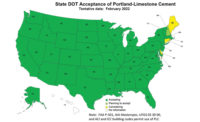In about four months, startup Prometheus Materials expects to begin producing portland-cement-free “bio-masonry” units to replace embodied carbon-intensive cementitious masonry units, known as concrete block. The bio-blocks contain drastically less embodied carbon, thanks to a patent-pending photosynthetic bio-cementation process that combines nature's living microalgae with water, sunlight and CO₂.
The secret juice in the block is a biological binding agent, dubbed bio-cement, that replaces all of the portland cement, reducing EC in the material by 90%, says the startup. “We have discovered a way to accelerate the [bio-cementation] process,” and create a binding agent similar to the material that coral uses to build reefs and oysters use to generate shells, says Loren Burnett, co-founder, president and CEO of Prometheus.
"This is a radical departure from standard concrete production," says Wil Srubar III, co-founder and chief technology advisor at Prometheus. By eliminating portland cement, "we are curing the source of the [embodied carbon] problem in concrete, not the symptoms," adds Srubar, also a professor of materials science engineering at the University of Colorado Boulder and lead principal investigator of the UC Boulder team that invented the bio-cement, under a $2-million grant from the U.S. Dept. of Defense.
Novel Technology
The novel technology has “merit” and “potential,” says Andreas Tselebidis, director of sustainable concrete technology and solutions at Masterbuilder Solutions, who is not involved with Prometheus.
“Algae and proteins will work,” adds Tselebidis. “The question is whether we can use this technology as a structural material,” perhaps in combination with other ingredients, he says.
Tselebidis says much still needs to be tested to determine the structural and mechanical properties and the performance characteristics of the material, especially over time and under different weather conditions.
Structural Bio-concrete
“We will absolutely be involved in structural concrete as well,” perhaps with fibrous support instead of reinforcing steel, says Burnett. But it will take about two years to get through the certification process, he adds.
The biocement is a hydrogel-based living building material containing bacteria capable of microbially induced calcium-carbonate precipitation. LBMs are made by microorganisms.
The product is the brainchild of the four principal investigators of the research at the university, all of whom also are co-founders of Prometheus. The co-inventors, in addition to Srubar, are Mija Hubler, Sherri M. Cook and Jeffrey C. Cameron.
On June 6, Prometheus announced it had closed its $8-million Series A financing round. The deal is allowing it to commercialize the bio-cement block at its plant in Longmont, Colo.
The product, with 2,000-psi compressive strength, will be marketed as an affordable, strong and durable near-zero-carbon alternative to portland cement-based concrete masonry units, says Prometheus.
No Pricing Details Yet
Burnett says there are no pricing details yet. “We will have a better idea of a cost profile in the fourth quarter of this year when we are in production,” he says.
To further reduce the EC of the product, Prometheus will purchase renewable power for the plant and install solar PV. Burnett expects the bio-block to be a net-sequesterer of carbon, eventually.
Over the next two years, Prometheus also will use its funding to commercialize other net-zero-carbon building products. These include precast bio-composite elements—a decarbonized alternative to traditional precast portland cement-based roofing tiles, wall panels, sound barriers and other concrete elements.
The company also expects to produce a ready-mixed bio-composite—a decarbonized alternative to traditional portland cement-based ready-mixed concrete.
Financing Deal
The financing deal was led by Sofinnova Partners, a European life sciences venture capital firm with offices in Paris, London and Milan. The Microsoft Climate Innovation Fund, architect-engineer Skidmore, Owings & Merrill (SOM), GAF and the Autodesk Foundation are participants.
SOM has for years sought to invest in green projects and products, says Brant Coletta, an SOM partner. "This rose up in our minds as something sustainable, accessible and usable," says Coletta. He is even more impressed that the products have as their building block an edible microorganism, akin to spirulina, which is used in healthful drinks.
SOM plans to design pavilions using bio-blocks, as soon as it is tested and approved. "It is not ready for specification yet," Coletta says.
To scale up availability in different regions, Prometheus is developing a licensing model under which it provides producers of the building products with the bio-material, which Burnett says is lightweight and easily shipped.
"This is all very exciting,” says Lionel Lemay, executive vice president of the National Ready-Mixed Concrete Association.
“NRMCA is supportive of all innovative technologies that can help us meet our carbon-neutrality goals,” adds Lemay. “This developing technology along with traditional technologies such as blended cements, supplementary cementitious materials and admixtures, [and] other exciting innovations, will help us get to zero carbon concrete by 2050.”




Post a comment to this article
Report Abusive Comment